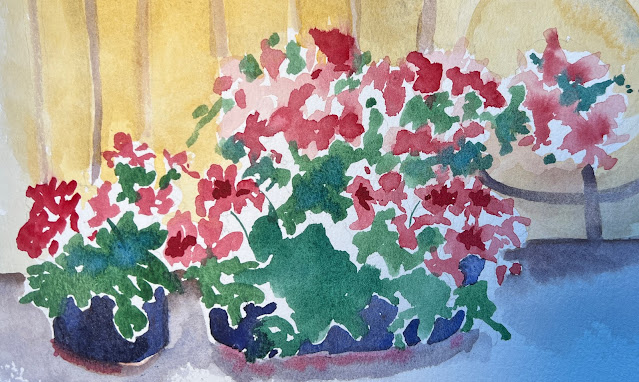 |
| Heart sculpture at Salesforce Park, one of many scattered around San Francisco |
One of art's purposes is to question your understanding of what you see around you. SF MOMA recently installed a thought-provoking exhibit of the work of sculptor Kara Walker called "Fortuna and the Immortality Garden." The garden includes 8 metal automatons embedded in obsidian rocks. It takes a moment to realize that each figure moves. One lifts its arms up and shakes the bells attached. Another strums strings along its belly. Each moves slowly and is mesmerizing to watch. The surfaces of the statues and the rocks are dark and foreboding. The information plaque about the grouping explains that the exhibit "considers the memorialization of trauma, the objectives of technology, and the possibilities of transforming the negative energies that plague contemporary society."
 |
| Part of Kara Walker's "Immortality Garden" at SF MOMA |
We stood in front of a 20-foot female figure, who very slowly spit out a piece of paper. The slips of paper covered the ground around her and looked like the paper from a fortune cookie. Each one had a different proclamation. Ours said:
 |
| A hopeful proclamation |
We sat down on the wooden staircase leading up to the main part of the museum and watched as the automatons moved. The exhibit is planted on the ground floor at the back entrance to the museum, which is a foot or so below street level. We both looked out the window behind the exhibit as a 6-foot tall rabbit, a Star Wars character, and a tiger-like being strolled by. Were they part of the exhibit?
No, they weren't, but the people had costumes so well created that we gathered ourselves up, walked out the door, and followed the strange costumes down the street. We found at the corner the entrance to the How Weird Street Faire at Howard and Second, which unbeknownst to us has roots from the Be-Ins in Golden Gate Park in the 1960s. We discovered that to enter we would have to hand over $40 each. We turned away wondering what the whole thing was about. We weren't dressed in costume and we felt bombarded by the too-loud music coming from the fair. We watched as more and more young, costumed people entered the fair. Later, after Googling the event, we discovered that its purpose is to encourage the union of art, music, and technology and to promote peace. I thought back about the two events, Kara Walker's Immortality Garden and the How Weird Faire. Their themes connected them together after all.
The fair is something to put on our list for next year. And don't miss the Kara Walker's exhibit either.
************
Find Kara Walker here:
https://www.sfmoma.org/exhibition/fortuna-and-the-immortality-garden-machine/
The How Weird Faire here:
.jpeg)









.jpeg)



